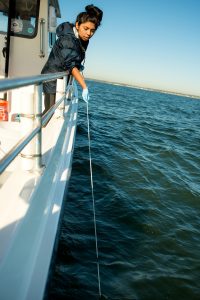
Erika collecting samples to monitor estrogenic activity within Raritan Bay. She also determined the effect of environmentally relevant levels of environmental estrogens on copepod mortality, growth rate, and reproduction for her Honors Thesis work.
The discharge of raw wastewater effluent has also led my research students to wonder about the presence of pharmaceuticals in wastewater effluent and effluent-receiving surface waters of the river and bay. Pharmaceuticals are considered emerging contaminants that are not commonly monitored in the environment but have the potential to enter the environment and cause adverse ecological and/or human health effects. Erika Hernandez ’17, is interested in measuring the concentrations of environmental estrogens, which have the potential to cause developmental and reproductive abnormalities in marine life, in samples from both the Raritan and from inside New Jersey wastewater treatment plants that discharge into the system. We want to know: 1) what are the concentrations of estrogenic hormones before and after wastewater treatment and in the Raritan River and Bay? and 2) are these concentrations biologically relevant? This is an important new area of water quality research.
LAB FAM members who have contributed to this project: Erika Hernandez ‘17
So far, her results indicate that:

